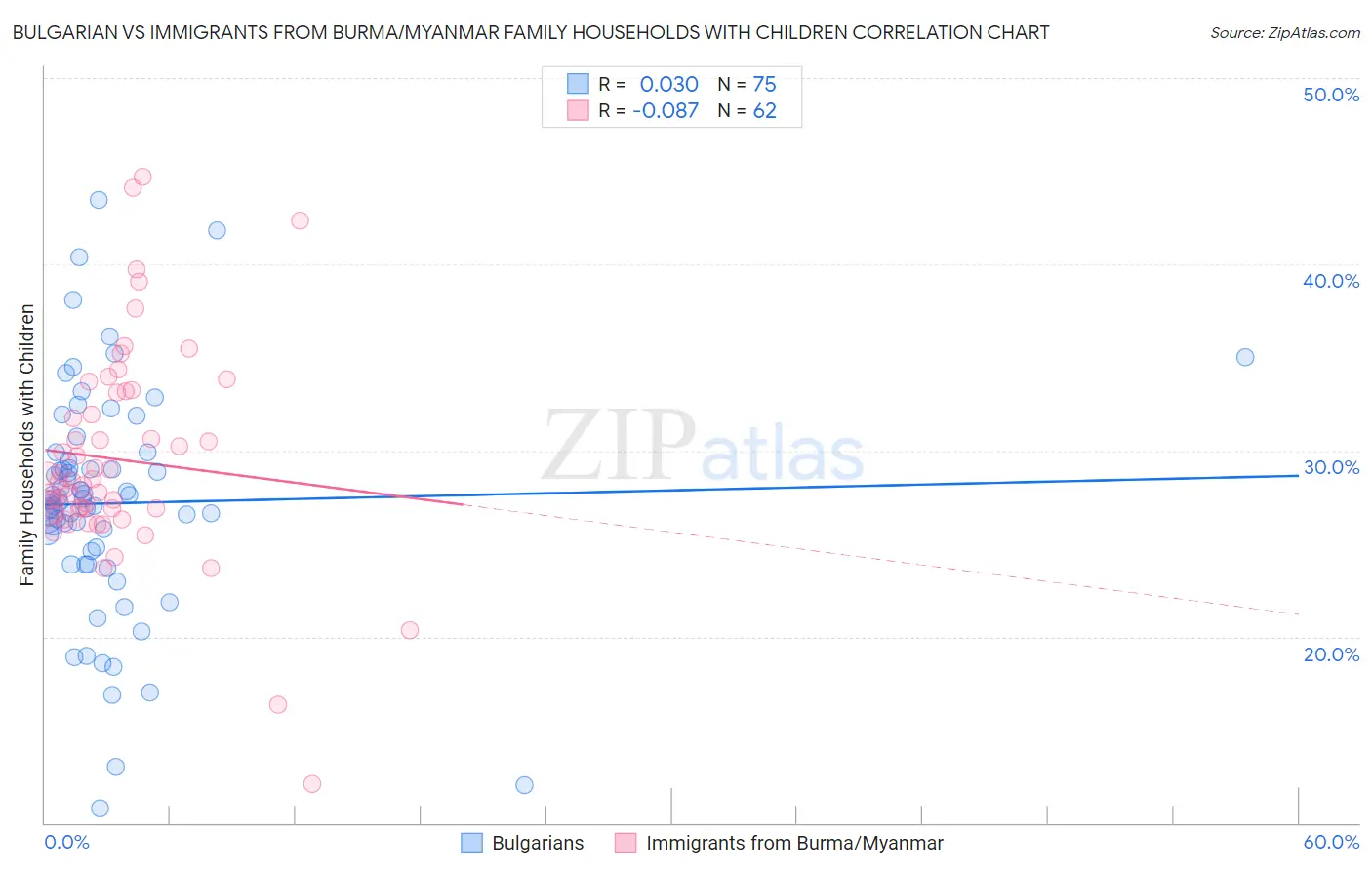Bulgarian vs Immigrants from Burma/Myanmar Family Households with Children
COMPARE
Bulgarian
Immigrants from Burma/Myanmar
Family Households with Children
Family Households with Children Comparison
Bulgarians
Immigrants from Burma/Myanmar
27.0%
FAMILY HOUSEHOLDS WITH CHILDREN
5.8/ 100
METRIC RATING
230th/ 347
METRIC RANK
28.0%
FAMILY HOUSEHOLDS WITH CHILDREN
97.7/ 100
METRIC RATING
108th/ 347
METRIC RANK
Bulgarian vs Immigrants from Burma/Myanmar Family Households with Children Correlation Chart
The statistical analysis conducted on geographies consisting of 205,477,079 people shows no correlation between the proportion of Bulgarians and percentage of family households with children in the United States with a correlation coefficient (R) of 0.030 and weighted average of 27.0%. Similarly, the statistical analysis conducted on geographies consisting of 172,235,396 people shows a slight negative correlation between the proportion of Immigrants from Burma/Myanmar and percentage of family households with children in the United States with a correlation coefficient (R) of -0.087 and weighted average of 28.0%, a difference of 3.6%.

Family Households with Children Correlation Summary
| Measurement | Bulgarian | Immigrants from Burma/Myanmar |
| Minimum | 10.8% | 12.1% |
| Maximum | 43.4% | 44.7% |
| Range | 32.7% | 32.6% |
| Mean | 27.2% | 29.5% |
| Median | 27.3% | 28.3% |
| Interquartile 25% (IQ1) | 24.6% | 26.9% |
| Interquartile 75% (IQ3) | 29.5% | 33.1% |
| Interquartile Range (IQR) | 4.9% | 6.2% |
| Standard Deviation (Sample) | 6.1% | 5.7% |
| Standard Deviation (Population) | 6.0% | 5.6% |
Similar Demographics by Family Households with Children
Demographics Similar to Bulgarians by Family Households with Children
In terms of family households with children, the demographic groups most similar to Bulgarians are Luxembourger (27.0%, a difference of 0.030%), Immigrants from Caribbean (27.0%, a difference of 0.050%), Yugoslavian (27.0%, a difference of 0.070%), Czechoslovakian (27.0%, a difference of 0.080%), and Tsimshian (27.0%, a difference of 0.080%).
| Demographics | Rating | Rank | Family Households with Children |
| Pima | 9.2 /100 | #223 | Tragic 27.1% |
| Germans | 8.7 /100 | #224 | Tragic 27.1% |
| Canadians | 7.5 /100 | #225 | Tragic 27.1% |
| Czechoslovakians | 6.6 /100 | #226 | Tragic 27.0% |
| Tsimshian | 6.6 /100 | #227 | Tragic 27.0% |
| Scottish | 6.5 /100 | #228 | Tragic 27.0% |
| Immigrants | Caribbean | 6.3 /100 | #229 | Tragic 27.0% |
| Bulgarians | 5.8 /100 | #230 | Tragic 27.0% |
| Luxembourgers | 5.5 /100 | #231 | Tragic 27.0% |
| Yugoslavians | 5.1 /100 | #232 | Tragic 27.0% |
| Immigrants | Italy | 5.0 /100 | #233 | Tragic 27.0% |
| Immigrants | Germany | 4.4 /100 | #234 | Tragic 27.0% |
| Immigrants | Morocco | 4.2 /100 | #235 | Tragic 27.0% |
| Cape Verdeans | 3.6 /100 | #236 | Tragic 26.9% |
| Immigrants | Netherlands | 3.5 /100 | #237 | Tragic 26.9% |
Demographics Similar to Immigrants from Burma/Myanmar by Family Households with Children
In terms of family households with children, the demographic groups most similar to Immigrants from Burma/Myanmar are Immigrants from Uganda (28.0%, a difference of 0.010%), Tohono O'odham (28.0%, a difference of 0.010%), Spaniard (28.0%, a difference of 0.050%), Immigrants from South America (28.0%, a difference of 0.080%), and Scandinavian (28.0%, a difference of 0.11%).
| Demographics | Rating | Rank | Family Households with Children |
| Immigrants | Oceania | 98.8 /100 | #101 | Exceptional 28.1% |
| Assyrians/Chaldeans/Syriacs | 98.7 /100 | #102 | Exceptional 28.1% |
| Palestinians | 98.5 /100 | #103 | Exceptional 28.1% |
| Sioux | 98.3 /100 | #104 | Exceptional 28.1% |
| Choctaw | 98.3 /100 | #105 | Exceptional 28.1% |
| Immigrants | South America | 98.0 /100 | #106 | Exceptional 28.0% |
| Immigrants | Uganda | 97.7 /100 | #107 | Exceptional 28.0% |
| Immigrants | Burma/Myanmar | 97.7 /100 | #108 | Exceptional 28.0% |
| Tohono O'odham | 97.6 /100 | #109 | Exceptional 28.0% |
| Spaniards | 97.4 /100 | #110 | Exceptional 28.0% |
| Scandinavians | 97.1 /100 | #111 | Exceptional 28.0% |
| Immigrants | Middle Africa | 97.0 /100 | #112 | Exceptional 28.0% |
| Arabs | 97.0 /100 | #113 | Exceptional 28.0% |
| South American Indians | 96.9 /100 | #114 | Exceptional 28.0% |
| Immigrants | Africa | 96.8 /100 | #115 | Exceptional 28.0% |